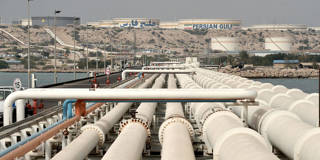If oil prices remain low over the long term, the Middle East could suffer a macroeconomic shock of historic proportions. Although some countries in the region are better positioned for revenue shortfalls than others, all will have to make tough choices now to ensure future prosperity.
CAMBRIDGE – Between 2014 and 2016, Middle Eastern oil-exporting countries’ revenues fell by an average of more than one-third – or 15% of GDP – and their current-account surpluses have swung violently to double-digit deficits. Notwithstanding a small recent uptick, most forecasts predict that oil prices will remain at current levels for the long term. If so, this will deliver a macroeconomic shock of historic proportions and profoundly change the Middle East.
Most oil-producing countries have already started to cut expenditures, borrow, and draw down their reserves. But countries with large external imbalances, low reserves, or high debts will increasingly feel financially constrained, if they don’t already. Low oil prices will hit Algeria, Bahrain, Iraq, Iran, Oman, and war-torn Libya and Yemen before the richer countries of the Gulf Cooperation Council. But, ultimately, each country’s economic fate will depend on the choices that it makes today.
Oil-producing countries can either cut consumption, or maintain it by improving productivity. Naturally, any country would prefer the latter, so the region’s governments are now trying to grow out of their problems by diversifying their economies.

CAMBRIDGE – Between 2014 and 2016, Middle Eastern oil-exporting countries’ revenues fell by an average of more than one-third – or 15% of GDP – and their current-account surpluses have swung violently to double-digit deficits. Notwithstanding a small recent uptick, most forecasts predict that oil prices will remain at current levels for the long term. If so, this will deliver a macroeconomic shock of historic proportions and profoundly change the Middle East.
Most oil-producing countries have already started to cut expenditures, borrow, and draw down their reserves. But countries with large external imbalances, low reserves, or high debts will increasingly feel financially constrained, if they don’t already. Low oil prices will hit Algeria, Bahrain, Iraq, Iran, Oman, and war-torn Libya and Yemen before the richer countries of the Gulf Cooperation Council. But, ultimately, each country’s economic fate will depend on the choices that it makes today.
Oil-producing countries can either cut consumption, or maintain it by improving productivity. Naturally, any country would prefer the latter, so the region’s governments are now trying to grow out of their problems by diversifying their economies.